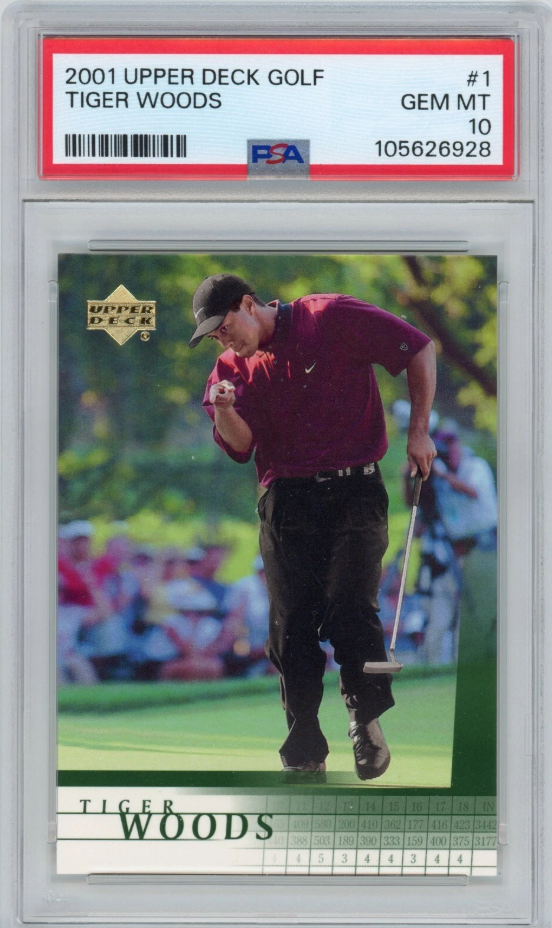In the vibrant, chaotic universe of sports memorabilia, few objects capture the imagination and withstand the fickle winds of the market quite like the 2001 Upper Deck Tiger Woods rookie card. This card doesn’t just sit quietly in a binder or display case; it demands attention, opening a floodgate of memories to a time when Tiger Woods transformed the landscape of golf with his tidal wave of victories. Fresh-faced on a brand-new golf product from Upper Deck, Woods graced card number one, erasing any doubts about who defined the game in that era.
There’s a magnetic quality to this card, a certain charisma that pulls collectors back again and again—like the irresistible pull of gravity. It’s a snapshot of Tiger’s rookie magic, a straightforward masterpiece in a world sometimes overrun by intricate designs and complex narratives. Ask any golf aficionado to show you what a Tiger rookie card looks like, and they’ll likely produce this very piece, no accompanying words needed.
To many, this card is the quintessential blue-chip golf card. It’s the perfect balance of availability and demand. There’s enough out there that dedicated collectors can locate one, yet clean copies never stay on the market long. Its nature is almost paradoxical—anchored deeply in history so much that its design feels like a time capsule, yet it’s not a relic time passed by.
For those who speak the language of charts and graphs, you’ll find the consistency reassuring. Card Ladder’s insights for the base PSA 10 on this card tell tales of stability; sales sprouted throughout summer in ranges tightly clustered from the low to mid three hundreds, forming a predictability band yet allowing individual nuances to play their part.
There’s beauty in simplicity. The card stands at the center of Woods’ cardboard saga, significant without secondary explanations. It’s the flagship base rookie, not merely a parallel or an obscure promo, from the set that rekindled mainstream interest in golf cards at the turn of the millennium. Its straightforward label—2001 Upper Deck Golf, card 1, Tiger Woods—adds not just clarity but an indelible charm. Its simplicity ensures liquidity across trading platforms and card shows, always ready to change hands.
Population dynamics and the conditions of these cards play into the ebb and flow of their market value. There are throngs of graded examples, a boon for long-term liquidity. Yet, even amidst this bounty, gem mint examples (those that make the PSA 10 grade) maintain an aura of rarity. They demand appreciation not just for their numbers but their immaculate presentation. Factors like off-centering or minute surface lines can make all the difference between a gem and a lesser grade, reflecting vividly in how these cards are valued and discussed.
The card’s design defies snubs—it has aged with grace. The classic photography, framed by borders that command the viewer’s focus, conveys simplicity that doesn’t try too hard. It’s a quality essential in diverse collections where this card shares the spotlight with Jordan inserts or a Brady chrome rookie. It fits both visually and historically without effort.
Collectors on their quest for this card often arrive by varied paths, each leading to logical reasons for acquiring it. For those who love the saga of a set, this card ties to the rebirth of golf cards under a mainstream brand. For fans following player career arcs, it’s a straightforward, graded rookie of an international icon, free of parallel mazes. For those who value liquidity, the consistency of comps is comforting, leaving no room for guesswork. It’s why many enthusiasts keep only this one piece in their golf card collection—it checks every box with a single slab.
When trying to budget for a PSA 10, note that observing eBay auctions is a wise place to start for the latest data. Most contests gravitate toward the 300 to 350 range, with sporadic prints just below. Patience pays off when pursuing a well-centered, brightly shot example. Meanwhile, for those seeking PSA 9s or choosing to buy raw, clear imagery is vital, paying close attention to corners and edges for telltale wear.
For thrill-seekers, there’s also the card-breaking adventure. The 2001 Upper Deck Tiger Woods rookie can sneak up in sports card repacks like those curated by Silver, Gold, and Platinum Galaxy Rip Packs. With no odds assured, each rip is a chance to pen a legendary tale.
This card exists at a poignant intersection—nostalgia and the present moment. It’s a relic reminding collectors of Sundays dominated by Tiger’s brilliance, yet comfortably sits in a contemporary collection where the metrics defining its worth are instantly accessible via smartphone. This duality explains the serenity of its price history and its capacity to ignite excitement anew when glimpsed out of its case. With its clean photography, iconic rookie status, and simplistic clarity, the card rolls up everything about meaningful cardboard into one elegantly defined gem.
